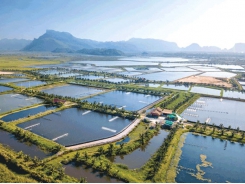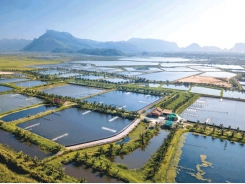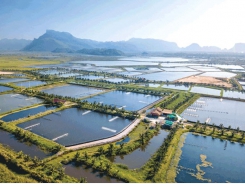Land Based Sustainable Aquaculture Strategy - Part 7

Be aware!
9/ Surface water access rules
NSW Office of Water (NOW) should be contacted to ascertain the current water access licensing rules applying to basic landholder rights, on farm dams, extraction from watercourses and any surface water licence embargoes that may apply to a selected site.
Groundwater access
All ground water bores must be of an approved diameter, lined and capped to the standards required and licensed by NOW.
You will need to consult with NOW on the principles and issues to be considered relating to groundwater, for example:
- groundwater quality, quantity and vulnerability;
- threats and protecting the resource;
- conservation of water resources.
Be aware!
10/ Groundwater access rules
Under Section 112 of the Water Act 1912, anyone using a bore or well must have a groundwater licence. There are a number of alluvial aquifers in NSW that are embargoed, and therefore no new water licences will be approved. However, applications can be made to transfer allocations from existing licences.
Any proposed use of groundwater in areas possessing ASS will need considerable environmental assessment to ensure that such extraction will not lower groundwater tables to levels leading to the formation of acidic ground water. NOW will generally require a full assessment of any works in areas mapped as having either vulnerable groundwater, or significant potential for ASS.
A licence or approval is required prior to the construction of any bore and all applications for licences are subject to assessment by NOW.
Sites that have underlying high quality fresh potable groundwater within 3 metres of the surface will require detailed investigations. The quality of the underlying groundwater should not be put at risk by the aquaculture activity, in particular where saline ponds are over fresh water aquifers. Any risk to groundwater used for potable water supplies may result in a proposed aquaculture development being refused.
Multiple use of recycled freshwater pond/tank or processing water
There are significant economic and environmental benefits to multiple water use. Multiple uses include hydroponics, horticulture or irrigated agriculture. Any irrigation schemes associated with aquaculture should be considered as a value adding process utilising the discharged water.
Pond siting
PREFERRED LOCATION
A pond aquaculture site not located in areas of high groundwater (within 3 metres of the surface), or areas highly vulnerable to groundwater contamination, which are used for stock, domestic or town water supplies.
If your area is one where there are ASS, you need to consider the cost of minimising the generation and runoff of acid into the ponds or neighbouring environment.
Sites with high groundwater are high risk for pond construction and management. It can be difficult to build the ponds and prevent seepage. It also may not be possible to adequately drain and dry out ponds built in such areas, something which is necessary for efficient pond management.
Flood liability
PREFERRED LOCATION
A site that is not within the flood planning area and/or a design that will not impede the flow of flood waters or affect catchment stormwater drainage. A site where the development is compatible with the relevant Council or DECCW floodplain management plan, where available.
Freshwater aquaculture ponds should be constructed above the probable maximum flood (PMF) level in the eastern drainage and constructed so not inundated by the discharge of a 1:100 ARI (average recurrent interval) flood event in the western drainage. In the western drainage if data is not readily available regarding the 1:100 ARI flood event a proponent may wish to consider the highest historic flood level. An aquaculture site within a flood planning area is likely to be severely impacted by floodwater and should therefore be avoided.
Ponds using estuarine or marine waters should be constructed above the 1:100 ARI flood event, although a case-by-case evaluation may be considered.
It is preferable that there is no major stormwater drainage across the site. If unavoidable, there should be sufficient space to manage the flows so as not to affect neighbouring properties or ecosystems.
Waterway protection
PREFERRED LOCATION
A site that allows for all infrastructure (except pipelines) to be at least 50 metres from the riparian zone.
Separation between the facility and any natural waterbodies is necessary to avoid disturbance of riparian vegetation and to allow for natural hydrological processes (such as bank erosion) without putting ponds or buildings at risk.
Disturbed buffer areas should be revegetated to prevent erosion and minimise flow into the waterbody. There should be a vegetated buffer zone of at least 20 to 40 metres between any effluent irrigated areas and the high bank of any adjoining watercourse.
Tip!
A buffer area of more than 40 metres would avoid the need for a controlled activities approval under the Water Management Act 2000. In addition, Aboriginal sites commonly occur adjacent to waterways, and a set back may reduce the likelihood of disturbance to Aboriginal sites.
Water temperature at a site
Water temperature is a key limiting factor in species selection and when selecting a site this must be considered. Information on freshwater temperatures is available for some river systems however it should be noted that water temperature within culture facilities is often much higher. Information on estuarine and seawater temperatures can be found using the following web link for a number of NSW coastal locations www.metoc.gov.au/products/data.html.
Related news
Tools

Phối trộn thức ăn chăn nuôi

Pha dung dịch thủy canh

Định mức cho tôm ăn

Phối trộn phân bón NPK

Xác định tỷ lệ tôm sống

Chuyển đổi đơn vị phân bón

Xác định công suất sục khí

Chuyển đổi đơn vị tôm

Tính diện tích nhà kính

Tính thể tích ao









 Land Based Sustainable Aquaculture Strategy…
Land Based Sustainable Aquaculture Strategy…  Land Based Sustainable Aquaculture Strategy…
Land Based Sustainable Aquaculture Strategy…